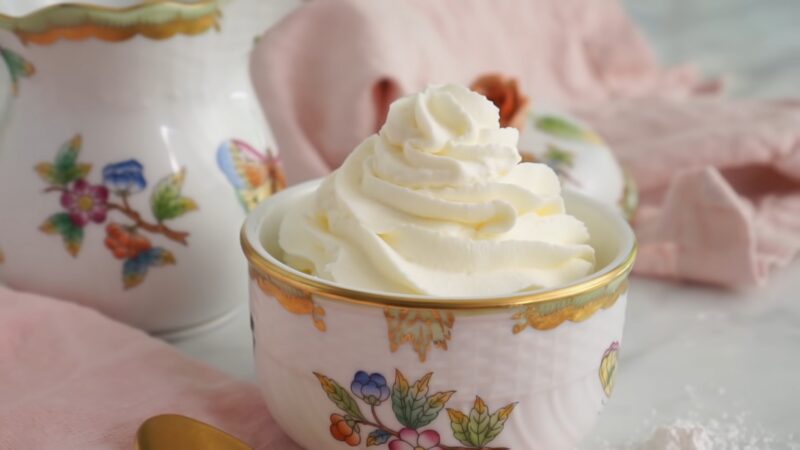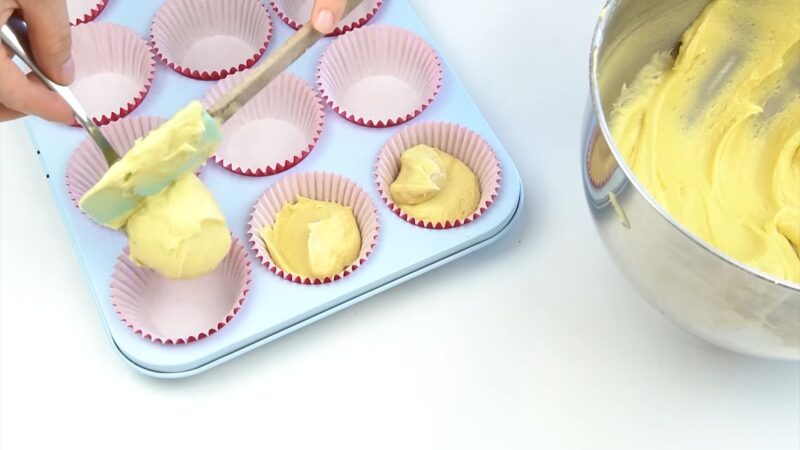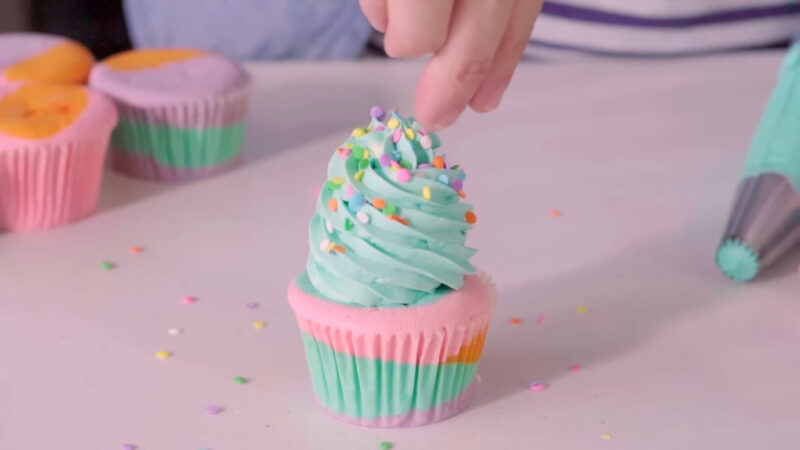If you enjoy baking, you know that there’s nothing quite as satisfying as baking a batch of delicious cupcakes and then giving them that perfect, delectable finish with beautifully frosted tops.
In this guide, I’m excited to share with you some of my favorite techniques and tips on how to frost cupcakes like a pro. From the essential tools you’ll need to achieve those Instagram-worthy swirls to creative ideas for decorating cupcakes for any occasion, we’ll explore this process step by step.
Frosting Types
1. Buttercream
Buttercream is a blend of butter, powdered sugar, and a liquid such as milk or cream, creating a smooth and creamy texture. It’s the most popular type of frosting due to its versatility and ease of flavoring. Ideal for both piping and spreading, buttercream is perfect for creating various textures and designs.
Its stability makes it suitable for intricate decorations and is often the go-to choice for wedding and birthday cupcakes.
It includes American buttercream, which is the simplest to make, Swiss meringue buttercream, known for its silky texture, Italian meringue buttercream, which is less sweet and more stable, and French buttercream, rich in flavor due to its egg yolk content.
2. Cream Cheese
Made by blending cream cheese with butter and powdered sugar, this frosting offers a tangy, rich flavor that complements a variety of cupcakes. Its creamy texture makes it easy to spread and pipe.
It is particularly excellent for pairing with red velvet or carrot cupcakes, cream cheese frosting adds a level of sophistication to simple flavors. Its tanginess balances the sweetness of the cupcakes, making it a favorite for adult palates.
3. Whipped Cream

This frosting is made by whipping heavy cream with sugar until light and airy. It’s less sweet compared to buttercream and has a delicate texture. It’s best for a light, less sweet topping, whipped cream frosting is ideal for fruit-flavored cupcakes or lighter cake bases like sponge or chiffon. It’s also a great choice for those who prefer a less sugary frosting.
Essential Tools for Frosting
| Tool | Description |
|---|---|
| Piping Bags | Essential for piping frosting onto cupcakes. They offer precision and control for intricate designs. |
| Piping Tips | Come in various shapes and sizes for creating different designs. Round tips for dots, star tips for texture, and petal tips for floral designs. |
| Offset Spatula | The key to spreading frosting smoothly. Its angled handle provides control for a professional, even layer of frosting. |
| Cupcake Stand/Tray | Not just for presentation; it’s practical for holding cupcakes while frosting. Elevates cupcakes for easier decorating and beautiful display. |
Preparing Your Cupcakes for Frosting
It’s crucial to let cupcakes cool completely before frosting. Attempting to frost warm cupcakes can result in melting frosting and messy presentation.
If the tops of your cupcakes are domed, it’s a good idea to level them with a knife for a flat surface. This provides a stable base for the frosting and ensures a uniform look.
Frosting Consistency
The right consistency is key for successful frosting. If it’s too stiff, it can be difficult to spread or pipe, and if too runny, it won’t hold its shape. Adjust with powdered sugar or liquid to achieve the perfect consistency.
Frosting Techniques for Beginners

Basic Piping Techniques
- Star Tip Technique: Attach a star tip to your piping bag and practice piping stars or rosettes onto a plate before moving to the cupcakes. This technique is great for creating textured, visually appealing designs.
- Round Tip Technique: This is perfect for creating classic swirls. Start from the outer edge of the cupcake and spiral towards the center, gradually lifting off at the top to create a peak. It’s simple yet elegant.
- Using Multiple Colors: For a vibrant, multicolored effect, stripe the inside of the piping bag with different colors of frosting before filling it. This creates a stunning rainbow or ombre effect when piped.
Spreading Techniques
- The Swirl: Using an offset spatula, start with a dollop of frosting in the center, then spread outward in a circular motion. This technique creates a rustic, yet charming look that’s perfect for casual gatherings.
- The Smooth Top: For a sleek, modern look, spread frosting evenly with a spatula, then smooth the top by lightly dragging the spatula across it. This technique is ideal for a minimalist or elegant design approach.
How to Perfect Your Technique – Tips and Tricks
Maintaining consistent pressure is crucial for even frosting. Practice squeezing the bag with a steady hand to achieve uniform designs. The angle at which you hold the bag can greatly affect the design. For example, a 90-degree angle is ideal for rosettes, while a 45-degree angle is better for swirls.
Room temperature frosting is easier to work with, as it flows smoothly and holds its shape well. If your frosting becomes too soft, refrigerate it briefly to firm it up.
Common Issues
Frosting Too Thin
If your frosting is too runny, add more powdered sugar a little at a time until the desired consistency is reached.
Frosting Too Thick
Conversely, if your frosting is too thick, thin it with a small amount of milk or cream, adding just a bit at a time to avoid making it too runny.
Uneven Frosting
Practice is key to achieving perfect frosting. Try to maintain a consistent speed and pressure when piping or spreading.
Creative Frosting Ideas
Ombre Effect: To create a stunning ombre look, gradually change the color of your frosting. Start with a darker shade at the base and lighten as you go up.
Flower Designs: Utilize petal tips to create beautiful floral designs on your cupcakes. Experiment with different colors and shapes to mimic various types of flowers.
Themed Cupcakes: Coordinate your frosting with holiday themes or party motifs for an extra flair. For example, create Santa hats for Christmas or pastel flowers for Easter.
Choosing the Right Frosting

The magic of a great cupcake lies in how well the frosting complements the base. A citrusy cupcake, for instance, pairs wonderfully with a rich cream cheese frosting, while a decadent chocolate cupcake may be best balanced with a light and fluffy vanilla buttercream.
Texture plays a key role in the overall experience of eating a cupcake. A moist, dense cupcake base, like a rich chocolate or a velvety red velvet, contrasts beautifully with a light and airy whipped cream frosting, providing a delightful sensory contrast.
Embrace the seasons in your cupcake creations. A pumpkin spice frosting can add a warm, comforting touch to cupcakes in the fall, while a light, berry-flavored frosting can be refreshing in the summer months.
Infusing Flavors into Frosting
- Extracts and Essences: A simple addition of vanilla, almond, or lemon extract can significantly transform your frosting. These essences deepen the flavor profile and can be easily adjusted to complement the cupcake’s flavor.
- Fruit Purees: Adding fruit purees like raspberry, strawberry, or lemon can infuse your frosting with a burst of natural, fresh flavors. These are particularly great in summer or for fruit-themed cupcakes.
- Spices and Zests: Incorporating spices like cinnamon, and nutmeg, or even adding citrus zests like lemon or orange can add a unique and delightful twist to your frosting, creating a more complex and layered taste experience.
Serving Tips
Cupcakes are best served at room temperature, as this allows the flavors to fully develop and the frosting to be at its optimal texture. If you’re not serving your cupcakes immediately, store them in an airtight container to keep them fresh.
Be mindful of the frosting type; some may require refrigeration. A cupcake stand not only makes for an attractive display but also makes it easier for guests to pick their choice. It elevates the cupcakes, showcasing the designs and making them a centerpiece of your event.
How to Make the Frosting Healthier
Reduce the Sugar!
For a healthier frosting, consider reducing the sugar content. You can also experiment with sugar substitutes, but be mindful of how they affect the texture and taste of the frosting.
Use Vegan Frostings
Vegan frostings, using plant-based butter and milk alternatives, can be just as delicious as traditional frostings. They cater to those with dairy restrictions and often have a unique, delightful flavor profile.
Look for Gluten-free Options
If you’re catering to those with gluten sensitivities, ensure that your frosting ingredients are gluten-free. Many frosting recipes are naturally gluten-free, but always check labels, especially for additives in pre-made ingredients.
Alternative Ingredients
- Coconut Cream: For a dairy-free alternative, coconut cream can be whipped into a delicious and creamy frosting. It adds a subtle coconut flavor, which can be a delightful pairing with tropical-flavored cupcakes.
- Avocado: Avocado can be used as a healthy base for a creamy frosting. It’s rich in good fats and provides a smooth, spreadable texture, ideal for a more natural and nutritious frosting option.
- Dates or Maple Syrup: For a natural sweetener, consider blending dates or using maple syrup. These not only add sweetness but also impart a unique flavor, making your frosting stand out.
FAQs
Can I frost cupcakes a day in advance? How should I store them?
Yes, you can. Store them in an airtight container in the refrigerator to keep the frosting fresh. Before serving, let them come to room temperature for about an hour for optimal flavor and texture.
How can I make my buttercream frosting less sweet without compromising its texture?
To reduce sweetness in buttercream frosting without affecting its texture, you can add a pinch of salt or a small amount of a neutral-tasting acid like lemon juice. These ingredients balance the sweetness without altering the consistency.
What’s the best way to color frosting naturally?
For natural coloring, use fruit and vegetable purees or powders. Beetroot for red, spinach for green, and blueberries for purple are good options. Remember that natural colors might be less vibrant than artificial ones.
How do I fix a curdled buttercream frosting?
To fix curdled buttercream, try warming it slightly by placing the bowl over a pot of simmering water for a few moments, then re-whipping it. Alternatively, adding a small amount of heavy cream and whipping again can also help.
Is it possible to frost cupcakes without a piping bag?
Absolutely! You can use a zip-top plastic bag with a corner snipped off as a makeshift piping bag. For a rustic look, simply use a knife or an offset spatula to apply and spread the frosting.
Can I make frosting ahead of time and how long will it last in the fridge?
Yes, most frostings can be made ahead of time. Buttercream and cream cheese frosting can last up to a week in the refrigerator when stored in an airtight container. Be sure to let it come to room temperature and re-whip it before use to ensure a smooth consistency.
Summary
Frosting cupcakes is a creative process that allows for endless experimentation and personalization. From the flavors and textures to the presentation and decoration, each element plays a role in creating the perfect cupcake experience.
So, grab your piping bag and spatula, and let your culinary creativity flow!
